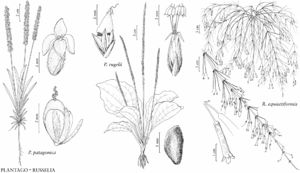Plantago rugelii
Prodr. 13(1): 700. 1852.
Perennials, sometimes annuals; caudex absent; roots fibrous, thick. Stems 0–20 mm. Leaves 20–150 × 10–120 mm; petiole to 200 mm; blade ovate to cordate-ovate, margins entire or toothed, veins conspicuous, surfaces glabrous or hirsute. Scapes 50–250 mm, glabrous or hirsute. Spikes brownish or greenish, 50–300 mm, densely or loosely flowered; bracts narrowly lanceolate, 2 mm, length 1–1.2 times sepals. Flowers: sepals 1.5–2 mm; corolla radially symmetric, lobes reflexed, 0.5–1 mm, base obtuse; stamens 4. Fruits 4–6(–8) mm, dehiscing proximal to middle. Seeds 4 or 5(–8), 1.5–2 mm. 2n = 24.
Phenology: Flowering summer.
Habitat: Open woods, meadows, pastures, waste places.
Elevation: 0–2000 m.
Distribution
N.B., N.S., Ont., Que., Ala., Ark., Conn., Del., D.C., Fla., Ga., Ill., Ind., Iowa, Kans., Ky., La., Maine, Md., Mass., Mich., Minn., Miss., Mo., Mont., Nebr., N.H., N.J., N.Y., N.C., N.Dak., Ohio, Okla., Pa., R.I., S.C., S.Dak., Tenn., Tex., Vt., Va., W.Va., Wis.
Discussion
Plants of Plantago major and P. rugelii are morphologically indistinguishable when young; they may be differentiated with certainty only at fruiting stage. DNA sequence data (A. Shipunov et al. 2014) confirm that the two species are distinct: P. rugelii is different from P. major by 11 substitutions in the ITS2 sequence.
Selected References
None.
